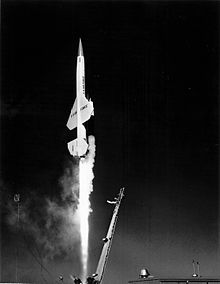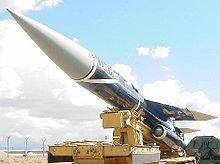
Back CIM-10 Bomarc Czech Bomarc German CIM-10 Bomarc Spanish CIM-10 Bomarc Finnish CIM-10 Bomarc French CIM-10 Bomarc ID CIM-10 Bomarc Italian CIM-10 ボマーク Japanese Boeing CIM-10 Bomarc Dutch BOMARC Polish
| CIM-10 Bomarc | |
|---|---|
 | |
| Type | Surface-to-air missile |
| Place of origin | United States |
| Service history | |
| In service | 1959 to 1 October 1972[2] |
| Used by | United States Air Force Royal Canadian Air Force Canadian Forces |
| Production history | |
| Manufacturer | Boeing Pilotless Aircraft Division[3] |
| Produced | 1958 |
| Specifications | |
| Diameter | 35 in (890 mm) |
| Wingspan | 218.2 in (5,540 mm) |
| Warhead | W40 nuclear warhead |
| Engine |
|
| Flight ceiling | 100,000 ft (30,000 m) |
Guidance system | Initially ground-controlled, active radar homing terminal guidance |

The Boeing CIM-10 Bomarc ("Boeing Michigan Aeronautical Research Center") (IM-99 Weapon System[4] prior to September 1962)[5][6] was a supersonic ramjet powered long-range surface-to-air missile (SAM) used during the Cold War for the air defense of North America. In addition to being the first operational long-range SAM and the first operational pulse doppler aviation radar,[7] it was the only SAM deployed by the United States Air Force.
Stored horizontally in a launcher shelter with a movable roof, the missile was erected, fired vertically using rocket boosters to high altitude, and then tipped over into a horizontal Mach 2.5 cruise powered by ramjet engines. This lofted trajectory allowed the missile to operate at a maximum range as great as 430 mi (690 km). Controlled from the ground for most of its flight, when it reached the target area it was commanded to begin a dive, activating an onboard active radar homing seeker for terminal guidance. A radar proximity fuse detonated the warhead, either a large conventional explosive or the W40 nuclear warhead.
The Air Force originally planned for a total of 52 sites covering most of the major cities and industrial regions in the US. The US Army was deploying their own systems at the same time, and the two services fought constantly both in political circles and in the press. Development dragged on, and by the time it was ready for deployment in the late 1950s, the nuclear threat had moved from manned bombers to the intercontinental ballistic missile (ICBM). By this time the Army had successfully deployed the much shorter range Nike Hercules that they claimed filled any possible need through the 1960s, in spite of Air Force claims to the contrary.[8]
As testing continued, the Air Force reduced its plans to sixteen sites, and then again to eight with an additional two sites in Canada. The first US site was declared operational in 1959, but with only a single working missile. Bringing the rest of the missiles into service took years, by which time the system was obsolete. Deactivations began in 1969 and by 1972 all Bomarc sites had been shut down. A small number were used as target drones, and only a few remain on display today.
- ^ Cite error: The named reference
IBMwas invoked but never defined (see the help page). - ^ Lombardi, Michael. "Reach for the sky" (PDF). Boeing Frontiers. Archived (PDF) from the original on 20 October 2011. Retrieved 3 November 2018.
- ^ Cite error: The named reference
FlightGlobalwas invoked but never defined (see the help page). - ^ Cite error: The named reference
AFD100617was invoked but never defined (see the help page). - ^ Wragg, David W. (1973). A Dictionary of Aviation (first ed.). Osprey. p. 69. ISBN 9780850451634.
- ^ Baugher, Joe. "Boeing/MARC F-99". JoeBaugher.com. Retrieved 4 August 2013.
- ^ Tactical missile aerodynamics, Volume 141. P17. Michael J. Hemsch, American Institute of Aeronautics and Astronautics. American Institute of Aeronautics and Astronautics, 1992
- ^ Tactical missile aerodynamics, Volume 141. Michael J. Hemsch, American Institute of Aeronautics and Astronautics. American Institute of Aeronautics and Astronautics, 1992
© MMXXIII Rich X Search. We shall prevail. All rights reserved. Rich X Search